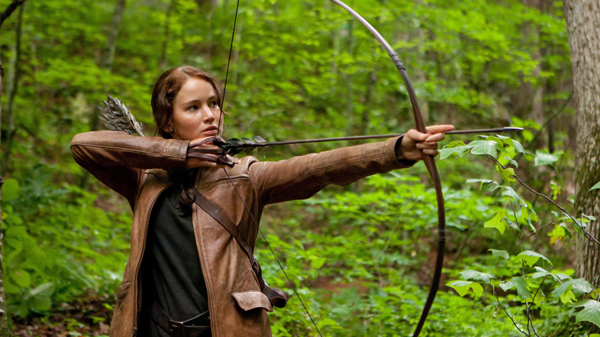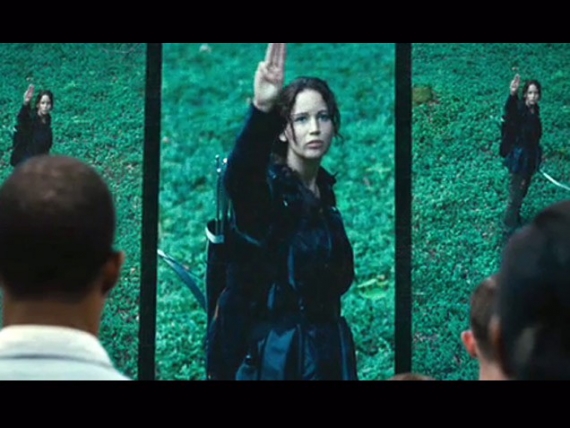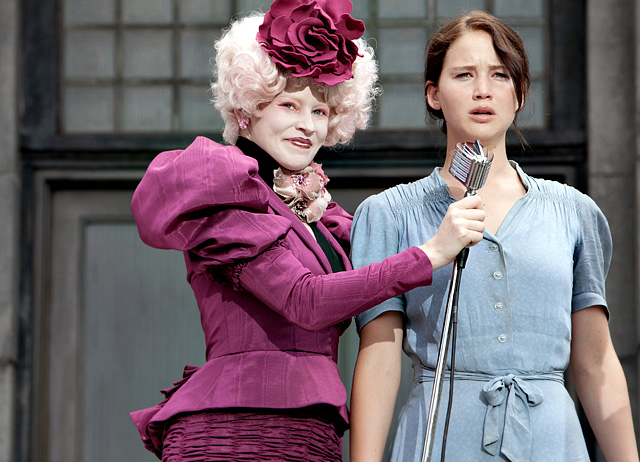
Courtesy of Lionsgate Films
The Hunger Games, the smash literary phenomenon, about a dystopian future in which 24 children fight to the death gets the big screen treatment as Lionsgate aims to kick-start a new franchise. So how does the film fare?
Let’s bitch it out…(Mild Spoilers ahead)
In the event that you’ve been living under a rock for the past year or so, here is a quick recap: The Hunger Games is set in a near future America in which – after a bloody rebellion – each of the 12 Districts that comprise Panem are forced each year to send two tributes – one male, one female – to compete in the bloody titular contest. Katniss Everdeen (Jennifer Lawrence) is a strong willed woman from District 12 who takes the place of her younger sister Prim (Willow Shields) after she is selected as female tribute at the Reaping event. After tearful goodbyes with her family, Katniss travels with her male counterpart – a boy named Peeta Mellark (Josh Hutcherson) – with their handler, Effie (a hilariously uptight Elizabeth Banks) and Mentor, Haymitch (Woody Harrelson) to the Capitol. There the two tributes meet the other 22 competitors from the other 11 Districts, attempt to impress the indulgent Capitol crowds before being released into the playing field from which only one will emerge as survivor and victor of the 74th annual game.
A few caveats to begin:
- The Hunger Games is not Twilight: People love to compare the two because they’re both massively popular books that feature female protagonists and love triangles. Whereas the Bella-Edward-Jacob fronted franchise (due to conclude in film format this November) is principally a supernatural tinged romance, the Katniss fronted series is not a love story. It is a brutal story about revolution, power and survival with a love triangle gingerly thrown in the mix. The two franchises are not comparable.
- The Hunger Games is not Battle Royale: This is the other main comparison detractors like to make, which is that Hunger author Suzanne Collins simply copied the formula established in the 1999 book written by Koushun Takami that was turned into a 2000 film by Kinji Fukasaku. There is more validity to this argument than the Twilight comparison, but again, simply because both concern televised contests in which children kill each other does not mean that they are the same text. Battle Royale is more adult, and it is more satirical (it also speaks to a particular cultural moment in Japanese history in which children were increasingly acting out against adults). In truth, the idea of humans hunting humans has been around for decades. See also: Richard Connell’s The Most Dangerous Game, Stephen King’s The Running Man, etc.
Alright, so let’s talk about the actual movie itself.
I’ve read the three books that comprise the series (which includes the sequel, Catching Fire, due out in film form in November 2013, and the third book, Mockingjay). After following the development of the film for the last year, with each casting notice dissected and discussed (Lawrence is too white and healthy looking, Hemsworth and Hutcherson should switch roles!), it’s been a long road to the silver screen. But with all of the speculation behind us, we can now objectively evaluate whether it succeeds as a film.
And it does. And it’s fantastic…

Courtesy of Lionsgate Films
Director Gary Ross (Seabiscuit, Pleasantville) may have seemed like an unconventional choice for a big budget, special effects action film, but he absolutely understands this material and what makes the story tick. His close relationship with author Collins and lead actress/star Lawrence is evident throughout the film as he keeps Katniss front and centre so that the audience is tied to her and her experiences.
The early scenes of the film are the most jarring because they employ what audiences have (not-so) lovingly defined as “shaky cam” – handheld cameras that zoom and jarring edits that can make some audience members feel disoriented or even nauseous (see: The Blair Witch Project, Friday Night Lights). While some have difficulty with it, it is often incredibly effective for conveying action and energy, which is something that The Hunger Games has in spades. What audiences who are unfamiliar with the source text may find surprising is the amount of time that is spent on the portions before the players enter the game. It is crucial that we understand the world that helped shape Katniss and Peeta (District 12’s coal sector is depressingly conveyed in mud, drab gray clothes and poverty stricken people – it’s dour and very well done). We also need to see the stark contrast between this life and the world of the Capitol, where citizens flaunt their wealth and ignorance of the outer Districts with garishly bright coloured clothes, ridiculous hairstyles and cosmetic enhancements. This is never more obvious than when handler Effie introduces the District 12 Reaping in a vibrant purple outfit which stands out against the muted brown, grey and blue palette (see picture below).

Courtesy of Lionsgate
And that’s just a small piece of what works. Concerns over casting for the principal players is universally muted moments after their introduction (with the potential exception of Hemworth’s Gale – Katniss’ childhood friend – and Hutcherson’s Peeta, though I would argue that that is because neither is given a significant amount to do). Stanley Tucci’s Caesar Flickerman, a television personality who interviews the Tributes and provides game commentary, is absolutely spot-on in his over-the-top personality and magnetic smile, as is Banks, who is alternately deluded and hilariously uptight as Effie. Harrelson as District 12 mentor Haymitch is appropriately drunk, angry and compassionate; Seneca Crane (Wes Bentley) also fares well as the man who creates the game environment and helps to shape the show, while Donald Sutherland, in his few scenes, is the right amount of shady and intimidating as President Snow.
Overall, however, the story is Lawrence’s to carry as she breathes life into a character that is in virtually every shot of the film. When a fellow tribute she cares for dies, Lawrence makes you cry. When she has a tender moment with Peeta, she ensures that you’re uncertain whether she’s truly falling for him or following through on the plan to deliver a love story that entices rich viewers to support them with gifts. And when she needs to wield her bow, or survive a knife attack, or outrun a wall of flames in the forest, you absolutely believe that she can not only hold her own, but that she has the power to inspire those who believe in her.
There were many questions about how violence would be handled in the film, especially considering the “child friendly” rating designed to ensure younger fans could see their favourite characters come to life onscreen. Ross directs this well, frequently tying the view of the carnage to Katniss’ mental state. When she is overwhelmed, the action is scattershot and confusing (such as the initial bloodbath at the Cornucopia when the games first begin). When she comes across the deformed body of a Tribute who has been stung to death by genetically modified trackerjacker wasps, Katniss’ hallucinatory state blurs our vision of the corpse. The only time that we truly see bloody violence is when the death in question is meant to cause us a great deal of grief and pain, just as it does Katniss, whose reaction is appropriately distraught.
Speaking of deaths, one of my biggest surprises is the suggested death of a character who survives in the book. This alteration – if it is actually followed through – will have a significant impact on the future of the series. This change, as well as a few new scenes between President Snow and games supervisor Seneca Crane, are the only significant departures from the book, which appears to have followed the Harry Potter model of adaptation and stuck close to its source material.
What results is an action adventure film with a great deal of heart, fantastic performances from its cast and the creation of a vibrant, fully fleshed-out world. The film is long (almost two and a half hours), but time passes quickly (you’ll want more time with Effie, Caesar, Haymitch around both District 12 and the Capitol). I’m unsure how the experience plays to newbies, but as a big fan of the book, this met and exceeded my expectations. Frankly I can’t wait to revisit the film, as well as see how the more complicated material in the second and third books play out onscreen.
So basically you should stop reading this review and go see the film. And may the odds be ever in your favour…
The Hunger Games is now playing.
Great review and I totally agree. I was really very impressed with the film from beginning to end. I wish Peeta had been a little more complicated (as he is in the book) and I wish they had addressed the Avoxes. But those quibbles are so, so minor. I loved the adaptation.
Agree about the Avoxes (they looked strangely reminiscent of Handmaids), though I had read in advance that they were one of the elements that Ross felt they couldn’t do justice with in the time that they had. We also noticed that they kept the meeting with the couple in the woods out, though narratively that wouldn’t have paid off until later so I think that was a wise decision.
While I enjoyed your review very much, I had to chuckle about you calling “Battle Royal” “satirical”. You don’t know much about Japanese satires, do you? 😉 Besides that, great review.